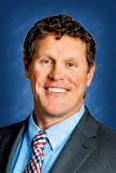




BY THERESA BOURKE Brainerd Dispatch
Everyone has their struggles. Larae Thomas’s just happens to be breast cancer.
“This is just a chapter in my life. It’s not my life story,” the Pillager woman said during an interview Wednesday, Sept. 25, at Christmas Point in Baxter.
The story started last November, when Thomas, 49, finally decided to get a lump in her breast checked out. It was time for her yearly physical and mammogram anyway. After a mammogram in December, she was called back for an ultrasound and then a biopsy.
“I’ve always kind of had that feeling in the back of my mind that I would end up with cancer at some point in my life because we have so much cancer on both sides of my family,” she said. “So I just had that feeling.” It turns out, her feeling was right.
The results came back the week between Christmas and New Year’s. Thomas received the call when she was at work but wasn’t as distraught as might be expected.
“You cry because it’s life-changing and you know everything’s going to be different, but I had that peace, too, of it’s
going to be OK. We’re going to handle it,” she said. That’s the mindset Thomas has strived to keep up over the past months, as she’s undergone chemotherapy, radiation, surgery and a host of complications.
Thomas’ cancer is triple positive, meaning it’s fueled by both the estrogen and progesterone hormones and the HER2 protein. Only about 10% of breast cancer cases fall into that category, which comes with both positives and negatives. On the downside, the cancer is aggressive and can spread quickly. On the upside, though, Thomas said there are more treatment options. At the advice of her daughter, who is a nurse, Thomas opted for a second opinion at the Mayo Clinic and is grateful for the world-class care she received both there and back home in Brainerd.
Doctors found more lumps after the initial ultrasound and biopsy, along with an enlarged mammary gland. Thus started the whirlwind of appointments, treatments and a new way of life.
Thomas underwent 12 weeks of chemotherapy and received two hormone blockers before opting for a double mastectomy to remove the cancer. She exhibited some of

the lesser seen symptoms from chemotherapy, like mouth sores and peeling fingernails, having to keep Band-aids on her fingers a lot of the time to keep the nails from coming apart completely. She also had to face her fear of losing her hair, which might have affected her more than the actual cancer diagnosis. She checked into a cold cap, which could help prevent hair loss during chemo, but the expense turned out to be too much, and the odds of it working were only 50/50. While Thomas didn’t lose all of her hair, the
change was still noticeable, after having colored her hair for years and watching it grow back with gray.
“I knew I was gray, and that’s why I colored my hair all the time,” she said. “But this is hard, looking at it. I get compliments all the time, but it’s not me.
“I remember looking in the mirror that day that I had been diagnosed and thinking, ‘Larae, you are never going to look the same again. You are going to look old.’ And that was really hard.”
Having previously worked as a school
secretary in Pillager and continuing to work in the nursery at her church, Thomas worried kids would be scared about her changing appearance. But it was another instance where she turned to God and knew he would help work through it.
Thomas had a support squad of 10 family members come down to the Mayo Clinic with her for her surgery, and they rented a house to stay at together while eating ice cream and celebrating the next step in Thomas’s journey.
“That’s my family,” she

RobynSchaeferis surroundedbyfamily atananniversary celebration.

said. “We always are looking for something to celebrate and a reason to eat food.”
The surgery was indeed a celebration, if not at least for the fact Thomas opted for that route instead of just a lumpectomy. The tumor in her breast was much larger than expected, and they discovered two more cancerous tumors in the lymph nodes in her armpits. Those latter tumors had not previously shown up on any other scans. After surgery came five weeks of 25 radiation treatments at Mayo Clinic in Rochester. Thomas stayed at the American Cancer Society Hope Lodge during her time there, with family members able to once again be by her side.
“That was amazing, being able to stay there and being with people that may not have the experience with breast cancer, but that are experiencing cancer, and we’re all in the same boat with getting radiation and being away from home,” Thomas said. With radiation came complications.
Two skin infections threw a wrench in the treatments, as did another, more severe issue. Thomas woke up one night with the kind of
THOMAS on B2




WhenIwastoldthatIhadanabnormalmammogram,Iwasterrified. IhadplannedonleavingthenextmorningforFloridaforfourmonths,andtheladyon thephonesaidIshouldhaveitcheckedwhenIreturned.That’swhenIlearnedmyfirstlesson:BeYourOwnAdvocate.Icanceledmytravelplansandscheduledanothermammogram. Aftertwomammograms,twoultrasoundsandsevenbiopsiesthefindingswereconflicting.Isupposedlyhadthree lesions,oneat3o’clock,6o’clockand9o’clock.Itdidn’tmakesensetome.Thesurgeonwasreadytodoalumpectomy ononebreast,butIsaid“No, takethemboth.”AfterthesurgerythedoctorsaidthatwasthesmartestdecisionIcould havemade;onebreastwasfullofcancer.Itisaterrifyingsituation.Askquestionsandresearchthepossibilities. Thedoctorsandnursesdothebesttheycan,buteachsituationisdifferent.Iamveryfortunate,we caughtitearlybeforeitspreadtomylymphnodes.Ihad30sessionsofradiationandnochemo.




IamcancerfreeandthankfulforthemedicalattentionIreceived!


pain and numbness associated with a heart attack. It wouldn’t be the last time those symptoms reared up during radiation either.
The symptoms ended up pointing to pericarditis, a rare side effect of radiation that sees swelling and irritation of the sac-like tissue surrounding the heart. Symptoms can mimic a heart attack.
Thomas was only the second patient her doctor had seen in 12 years to develop that condition after radiation.
Despite all the unforeseen problems and a couple painful nights in the ER, Thomas managed to finish her radiation treatments on time, even though it meant receiving three treatments in a 24-hour period.
“Which I do not recommend,” she said.
Now back at home, Thomas is technically cancer free but undergoing a new chemotherapy treatment and monthly Zoladex shots, which stop the ovaries from producing estrogen. She’ll continue getting those shots with a giant 16-gauge email either indefinitely, or until she can get a hysterectomy.
Chemo treatments should be done in April, after which Thomas hopes she can then have reconstruction surgery following the mastectomy.
A community of support
Throughout her cancer journey, Thomas has continually had a strong support system of people around her, including her husband, two daughters, sister, parents and countless other family members and friends.
Even though she no longer works at Pillager High School, the staff there decided to organize a fundraiser to help with hospital expenses. Thomas’ daughter played softball in Pillager, and Thomas always loved going to the games, so they decided on a Strike Out Cancer theme during a night when the varsity softball team played a late game under the lights.
She’s had to learn to humble herself a bit during this time in her life and allow other people to help her out.
“I’ve learned that allowing others to help you is there way of being able to heal, too. And I can’t take that away from them,” she said. “I would rather be the one helping everybody else, so that’s been a challenge for me.”

Sometimes even getting up in the morning is a challenge, too, but Thomas said it’s important to take those little steps each day of getting out of bed, taking a shower and getting dressed, even if she ends up just going right back to bed. That’s the advice she has for others struggling with their own cancer journey.
“Allowing yourself to sit there and wallow in your depression isn’t a good plan,” she said. “You’ve got to get up every morning.”
And keeping up with regular doctor’s visits and mammograms is an important step, too.

Thomas’s cancer was Stage 3, caught early enough to still be treatable, allowing her the time to continue living her life.
“God’s got this,” she said, noting everyone’s cancer story is different, but she hopes those facing the challenge might be able to find a little strength and a little hope from her own story.
THERESA BOURKE may be reached at theresa. bourke@brainerddispatch. com or 218-855-5860. Follow her on Twitter at www.twitter.com/ DispatchTheresa.









practicesfull-spectrumoncologyandhasaspecialinterest inthetreatmentofbreastcancer.Shewillbeseeing patientsatLakewood’sStaplesClinic.
BY MAYO CLINIC
If you’re concerned about getting breast cancer, you might wonder what you can do to help prevent it. You can’t change some risk factors, such as family history. But you can make lifestyle changes to lower your risk.
What can I do to lower my risk of breast cancer?
Research shows that lifestyle changes can lower the chances of getting breast cancer, even in people at high risk. To lower your risk:
Limit or stay away from alcohol. It’s safest not to drink alcohol. But if you do drink it, enjoy it in moderation. The more alcohol you have, the greater your risk of getting breast cancer. In general, women should have no more than one drink a day. Even small amounts raise the risk of breast cancer. One drink is about 12 ounces of beer, 5 ounces of wine, or 1.5 ounces of 80-proof distilled spirits.
• Stay at a healthy weight. Ask a member of your health care team whether your weight is healthy. If it is, work to maintain that weight. If you need to lose weight, ask your health care professional how to do so. Simple steps may help. Watch your portion sizes. Try to eat fewer calories. And slowly build up the amount of exercise you do.
• Get active. Physical activity can help you stay at a healthy weight, which helps prevent breast cancer. So try to move more and sit less. Most healthy adults should aim for at least 150 minutes a week of moderate aerobic exercise. Or try to get at least 75 minutes of vigorous aerobic exercise a week. Aerobic exercise gets your heart pumping. Some examples are walking, biking, running and swimming. Also aim to do strength training at least twice a week.
• Breastfeed. If you have a baby, breastfeeding might play a role in helping prevent breast cancer. The longer you breastfeed, the greater the protective effect. Limit hormone therapy after menopause. Combination hormone therapy uses estrogen and progestin. It may raise the risk of breast cancer. Talk with your health care professional about the risks and benefits of hormone therapy. You might be able to manage your symptoms with treatments and medicines that don’t use hormones. If you decide that the benefits of short-term hormone therapy outweigh the risks, use the lowest amount that works for you. Have your health care team track the length of time you take hormones.
• Studies show that estrogen alone in people who have had hysterectomies does not raise breast cancer risk. Estrogen is linked with a small increase in blood clot and stroke risk.
• If you smoke, quit. Some research suggests that smoking tobacco raises the risk of breast cancer. Breathing in another person’s cigarette smoke also may raise the risk. If you or a loved one needs help quitting, talk with a member of your health care team.
Can a healthy diet help prevent breast cancer?
Eating a healthy diet might lower your risk of some types of cancer. It also might lower the odds of getting diabetes and heart disease or having a stroke.
Some research suggests that people who eat a Mediterranean diet might have a lower risk of breast cancer, especially after menopause. The Mediterranean diet focuses mostly on plant foods. It includes fruits and vegetables, whole grains, legumes and nuts. People who follow the Mediterranean diet choose healthy fats such as extra-virgin olive oil over butter. And they eat fish instead of red meat. A balanced diet can help you stay at a healthy weight. And healthy weight is a key factor in helping prevent breast cancer. Is there a link between birth control pills and breast cancer?
Preventing unwanted pregnancy.
• Lowering the risk of other cancers, such as endometrial cancer and ovarian cancer.
What else can I do?
If you notice any changes in how your breasts look or feel, tell a member of your health care team right away. For example, get a checkup if you feel a new lump or see skin changes. And ask your health care professional when to start mammograms and other screening tests based on your medical history.
Some people have a
higher risk of breast cancer. This can be due to things such as having a family history of the disease or certain gene changes. If your health care professional tells you that your risk is higher, you may be advised to take steps such as:
Genetic counseling and testing.
• More-frequent breast exams. Breast cancer screening tests at an earlier age. Medicines or surgery to prevent breast cancer.
©2024 Mayo Foundation for Medical Education and Research (MRMER).


Saveupto25%onyourhomeandautoinsurancewhenyou bundlehome,autoandlifeinsurance.*
Wetailorcoveragetoyouruniqueneedsandofferdiscountsthatcouldsaveyoumoney. Calltodaytogetaquoteandseehowmuchyoucouldsave.
There’s some evidence that hormonal types of birth control raise the risk of breast cancer. These include birth control pills and intrauterine devices (IUDs) that release hormones. But the risk is very small. And it drops after you stop using hormonal birth control.
Talk with a member of your health care team about your birth control options. Your health care professional can help you weigh the benefits and risks. The benefits of birth control pills include: Controlling menstrual bleeding.
Saveupto25%onyourhomeandautoinsurancewhenyou
Saveupto25%onyourhomeandautoinsurancewhenyou bundlehome,autoandlifeinsurance.
Saveupto25%onyourhomeandautoinsurancewhenyou bundlehome,autoandlifeinsurance.
Wetailorcoveragetoyouruniqueneedsandofferdiscountsthatcouldsaveyoumoney. Calltodaytogetaquoteandseehowmuchyoucouldsave.

ShannonFinnegan,Agent Finnegan&Associates,Inc. 406WWashingtonStSte4 Brainerd,MN56401 (218)829-3040 sfinneg1@amfam.com
ShannonFinnegan,Agent Finnegan&Associates,Inc. 406WWashingtonStSte4 Brainerd,MN56401 (218)829-3040 sfinneg1@amfam.com
*Customerswhobundlehome,autoandlifepoliciesmaysaveupto25%ontheirhomeandautopoliciestogether(asofDecember2023).Discountsmayvarybystate,property,policyform andcompanyunderwritingtheautoand/orhomepolicy.Discountsmaynotapplytoallcoveragesonanautoorhomepolicy.Discountsdonotapplytolifeinsurancepolicies. ShannonFinnegan,Agent Finnegan&Associates,Inc. 406WWashingtonStSte4 Brainerd,MN56401 (218)829-3040 sfinneg1@amfam.com


*Customerswhobundlehome,autoandlifepoliciesmaysaveupto25%ontheirhomeandautopoliciestogether(asofDecember2023).Discountsmayvarybystate,property,policyform
*Customerswhobundlehome,autoandlifepoliciesmaysaveupto25%ontheirhomeandautopoliciestogether(asofDecember2023).Discountsmayvarybystate,property,policyform andcompanyunderwritingtheautoand/orhomepolicy.Discountsmaynotapplytoallcoveragesonanautoorhomepolicy.Discountsdonotapplytolifeinsurancepolicies.
*Customerswhobundlehome,autoandlifepoliciesmaysaveupto25%ontheirhomeandautopoliciestogether(asofDecember2023).Discountsmayvarybystate,property,policyform andcompanyunderwritingtheautoand/orhomepolicy.Discountsmaynotapplytoallcoveragesonanautoorhomepolicy.Discountsdonotapplytolifeinsurancepolicies.
AmericanFamilyMutualInsuranceCompany,S.I.&itsOperatingCompanies,AmericanFamilyLifeInsuranceCompany,6000AmericanParkway,Madison,WI53783©202321714–Rev.4/24–23246169
AmericanFamilyMutualInsuranceCompany,S.I.&itsOperatingCompanies,AmericanFamilyLifeInsuranceCompany,6000AmericanParkway,Madison,WI53783©202321714–Rev.4/24–23246169



BY MAYO CLINIC
There’s a lot of information to take into consideration when you’re thinking about getting a genetic test to find out if you carry one of the breast cancer susceptibility genes. You may have already considered the practical aspects of genetic testing, such as which test to undergo and the potential costs. But also consider some of the psychological, emotional and social implications of your genetic testing results. Here are some things to think about as you decide whether genetic testing for BRCA1, BRCA2 or the many other genes related to breast

cancer is right for you.
Positive test results If genetic testing reveals that you carry a gene with changes that increase your risk of breast cancer, you might experience a range of responses to learning your test results, including:
• Anxiety about developing cancer. Carrying an altered gene doesn’t mean you’ll definitely get cancer. Test results can’t determine your exact level of risk, at what age you may develop cancer or how aggressively the disease might progress. Relief of knowing your risk status. You may view your test results in a positive light: Now you know what you’re


up against. You can step up cancer surveillance efforts or take riskreducing steps, such as preventive surgery or medications. You also have the potential to inform and educate family members who may be affected.
• Strained family relationships. Some of your relatives may not want to know there’s been a worrisome gene detected within the family. But it may be hard to keep the truth from close family members if you’re planning proactive measures, such as preventive surgery. Give thought beforehand to how -- or even if -- you’ll share your test results with family members. Worry about passing a gene to your child.
Learning your genetic status could prompt fears that your children may have inherited the gene. If you learn that you are a carrier of a gene linked to breast cancer, this can lead to more questions and anxiety about when is the best time to discuss the results with your children.


Stress over major medi-
cal decisions. Receiving a positive test result means you’ll want to consider cancer prevention and early detection strategies that are best for you. Discussing options with a genetic counselor, breast specialist or oncologist can help guide you. Talk about these -- or any other -- concerns with your genetic counselor or other health care provider. Negative test results Learning that genetic testing found no gene changes that could increase breast cancer risk might produce feelings of: Relief that you’re less likely to have an increased cancer risk. If your test result is negative for gene changes that have been identified in other family members, you may feel like a huge weight has been lifted off your shoulders. However, given your family history, you’ll want to develop a screening plan with your health care provider that is right for you based on your particular situation.
• It would be a mistake to
let your negative test results lull you into a false sense of security. You still face the same level of cancer risk as the general population -- or maybe slightly higher because of your family history.
• “Survivor” guilt. Testing negative for gene changes that increase the risk of breast cancer may bring on feelings of guilt -- especially if other family members do carry the gene changes and face an increased cancer risk.
• Uncer tainty about your cancer risk. A negative test result doesn’t mean you have no risk of cancer. It may be difficult for your health care providers to draw definite conclusions about your risk of cancer.
Variant or unknown test results
In some instances, testing identifies gene changes that haven’t been seen in prior families with breast cancer, and there isn’t enough information about the gene changes to know whether they cause an increased risk of cancer. This is known as a variant of uncertain
significance.
Learning that you have a genetic variant of unknown significance may lead to: Confusion and anxiety about your cancer risk Frustration over the lack of accurate individualized cancer risk information
Challenges with making cancer screening, treatment and prevention decisions
Living with test results
Most people would be anxious if given the chance to find out whether their risk of a serious disease was higher than average. In fact, you may decide that you’d rather not know, and just forgo testing altogether. That’s a valid choice. It’s also common to experience sadness, anxiety or even anger if your test results are positive. However, research shows that, in the long run, most people cope well with the knowledge of an increased cancer risk and don’t experience significant distress over the test results.
©2024 Mayo Foundation for Medical Education and Research (MRMER).











